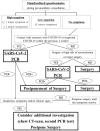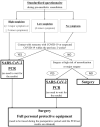Preoperative assessment for scheduling surgery during the coronavirus disease pandemic
- PMID: 33502589
- PMCID: PMC7838845
- DOI: 10.1007/s00540-021-02896-x
Preoperative assessment for scheduling surgery during the coronavirus disease pandemic
Abstract
On Mar 11, 2020, the World Health Organization declared coronavirus disease (COVID-19), caused by severe acute respiratory syndrome coronavirus-2 (SARS-CoV-2), a pandemic. Because COVID-19 has a pre-symptomatic period of up to 2 weeks, SARS-CoV-2 infection has continued to spread. Some individuals with SARS-CoV-2 infection have a severe clinical course, while most individuals have mild or moderate symptoms. Because SARS-CoV-2 is transmitted via droplets and secretions, anesthesiologists have higher risks of infection, especially during airway management. Therefore, general anesthesia requiring airway management can be a challenging procedure for anesthesiologists. During the pandemic, many elective surgeries have been postponed or cancelled in most affected countries. Recently, the number of elective surgeries is gradually recovering from the effect of the COVID-19 pandemic, and hence, safe clinical practice and protocols to prevent SARS-CoV-2 transmission to medical staff should be established. This mini-review focuses on the preoperative assessment and decision with regard to scheduling surgery in elective and emergency cases during the COVID-19 pandemic. A standardized questionnaire and algorithm regarding COVID-19 should be used to assess surgical patients preoperatively as it increases the reproducibility and accuracy of the decision whether to proceed with surgery.
Keywords: Anesthesia; COVID-19; SARS-CoV-2; Surgery.
Conflict of interest statement
K.S. has received speaker fees from Edwards Lifesciences and Otsuka Pharmaceutical Factory.
Figures


Similar articles
-
International Society for Gynecologic Endoscopy (ISGE) guidelines and recommendations on gynecological endoscopy during the evolutionary phases of the SARS-CoV-2 pandemic.Eur J Obstet Gynecol Reprod Biol. 2020 Oct;253:133-140. doi: 10.1016/j.ejogrb.2020.08.039. Epub 2020 Aug 26. Eur J Obstet Gynecol Reprod Biol. 2020. PMID: 32866856 Free PMC article. Review.
-
[Results of preoperative SARS-CoV-2 testing in the coronavirus pandemic].Urologe A. 2021 Mar;60(3):331-336. doi: 10.1007/s00120-021-01459-y. Epub 2021 Feb 9. Urologe A. 2021. PMID: 33559693 Free PMC article. Review. German.
-
Is it Safe to Perform Elective Colorectal Surgical Procedures during the COVID-19 Pandemic? A Single Institution Experience with 103 Patients.Clinics (Sao Paulo). 2021 Mar 24;76:e2507. doi: 10.6061/clinics/2021/e2507. eCollection 2021. Clinics (Sao Paulo). 2021. PMID: 33787677 Free PMC article.
-
General surgery practice under the COVID-19 pandemic: The experience of a pandemic hospital in Istanbul.Ulus Travma Acil Cerrahi Derg. 2022 Jan;28(2):175-179. doi: 10.14744/tjtes.2020.80025. Ulus Travma Acil Cerrahi Derg. 2022. PMID: 35099036 Free PMC article.
-
A prospective study on the incidence of postponed time-sensitive urological procedures during the SARS-CoV-2 pandemic due to patient preference.Ir J Med Sci. 2021 Aug;190(3):919-923. doi: 10.1007/s11845-020-02438-6. Epub 2020 Nov 17. Ir J Med Sci. 2021. PMID: 33201439 Free PMC article.
Cited by
-
Treatment and outcome of COVID-19 patients in a specialized hospital during the third wave: advance of age and increased mortality compared with the first/second waves.JA Clin Rep. 2021 Dec 14;7(1):85. doi: 10.1186/s40981-021-00489-x. JA Clin Rep. 2021. PMID: 34905146 Free PMC article.
-
Colorectal Surgery in the COVID-19 Pandemic Era.J Anus Rectum Colon. 2022 Jan 28;6(1):1-8. doi: 10.23922/jarc.2021-074. eCollection 2022. J Anus Rectum Colon. 2022. PMID: 35128131 Free PMC article. Review.
-
An Investigation for Future Practice of Elective Hip and Knee Arthroplasties during COVID-19 in Romania.Medicina (Kaunas). 2023 Feb 8;59(2):314. doi: 10.3390/medicina59020314. Medicina (Kaunas). 2023. PMID: 36837514 Free PMC article.
References
-
- Chan JF-W, Yuan S, Kok K-H, To KK-W, Chu H, Yang J, Xing F, Liu J, Yip CC-Y, Poon RW-S, Tsoi H-W, Lo SK-F, Chan K-H, Poon VK-M, Chan W-M, Ip JD, Cai J-P, Cheng VC-C, Chen H, Hui CK-M, Yuen K-Y. A familial cluster of pneumonia associated with the 2019 novel coronavirus indicating person-to-person transmission: a study of a family cluster. Lancet. 2020;395:514–523. doi: 10.1016/S0140-6736(20)30154-9. - DOI - PMC - PubMed
Publication types
MeSH terms
LinkOut - more resources
Full Text Sources
Other Literature Sources
Medical
Miscellaneous

